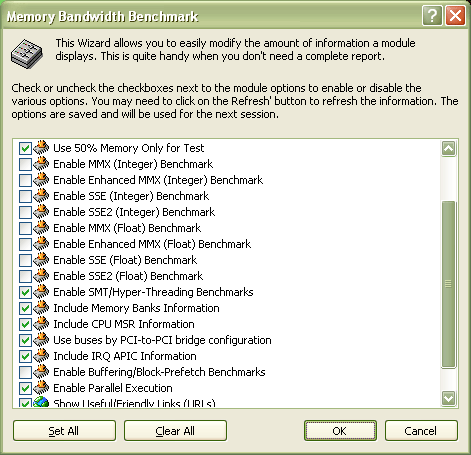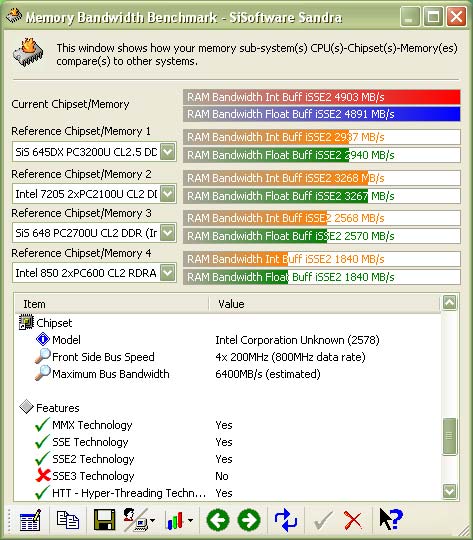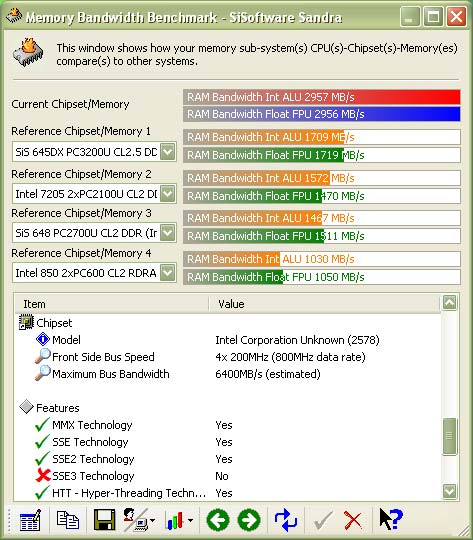Searching for the Memory Holy Grail: Part 1
by Wesley Fink on July 27, 2003 11:13 PM EST- Posted in
- Memory
Test Design
AnandTech has had reservations about the usefulness of synthetic benchmarks to measure the performance of computers. However, testing memory is one area where it is hard to avoid synthetic benchmarks. We were particularly concerned about some of the memory benchmarks we have seen posted with the 875/865 chipset boards. Some of the more widely-used synthetic benchmarks are being used to “demonstrate” performance that we logically know – based on Intel 865/865 chipsets white papers – to be not the case.
MemTest86
MemTest86 has been around for many years, and it is the standard in Memory Testing for many computer enthusiasts. The program boots from CD-ROM or floppy using its own DOS-like operating system, and tests memory at its most basic level. To many enthusiasts, this program is the ultimate test to determine the stability of memory. If you wonder why we would use such an ancient benchmark, it is because we have not found anything that is really better to test memory performance and stability. Apparently, we are not alone, since MemTest86 is still widely used in the Memory industry to test the stability of memory modules.
As a baseline, MemTest86 was run on an 875 Canterwood system with a Pentium 4 3.0GHz CPU and 2x512MB double-sided high-speed DIMMs at timings of 2,5,2,2. This gives us a MemTest86 score at Default Settings of 2,722MB/sec.
More information on MemTest86 is available at their site. Floppy and ISO versions of the program are also available at this site for download.
UNBuffered Memory Performance in Windows XP
In search of a reliable memory benchmark, we find that SiSoft Sandra 2003 is one of the more widely used memory benchmarks. Looking closer, we did not feel the standard Sandra memory test, which relies heavily on synthetic memory buffering techniques, provided the kind of sensitivity we needed for these tests. It is true that Sandra uses the same buffering techniques as in the CPU and chipset tests, but these buffering techniques themselves can often mask poor memory performance and sometimes provide memory performance scores that do not correlate well with real-world performance.
While we don’t know exactly where it started, we have seen a number of enthusiast sites using a variation of the Sandra Memory, which turns off buffering techniques and comes closer to measuring raw memory performance. Macci was one of the first to use the UNBuffered benchmark – the famous Finn who is always at or near the top of the 3DMark scores. In addition, Tony Leach in England and I have used it in many reviews on other web sites.
The idea of the UNBuffered Memory Benchmark is very simple – you merely turn off all memory buffering techniques. Sandra makes this very easy to do. Select ‘Memory Benchmark’, right-click ‘Module Options’, and uncheck the 9 boxes that have to do with buffering.

The UNBuffered Memory Benchmarks are quite different from what you may be accustomed to seeing. As an example, these are Buffered or Standard Memory benchmarks with two double-sided DIMMs on a 875 Canterwood board at stock 3.0GHz at DDR400 at memory timings of 2-5-2-2.

Using the same settings for the UNBuffered Memory Benchmark (3.0GHz, DDR400, 2-5-2-2, 2x512MB DIMMs), we achieved much lower numbers.

Please look carefully at the screen captures above, and notice that THE MEMORY BAR STATES “BUFF” IN THE DESRIPTION ON A STANDARD TEST. “BUFF” IS NOT USED IN THE DESCRIPTION IN THE UNBUFFERED MEMORY TEST
While the score of the UNBuffered benchmark is much lower than the standard Memory Test, the UNBuffered benchmarks are very comparable to MemTest86 results. This excellent correlation of MemTest86 and SiSoft Sandra UNBuffered Memory Test results seems to be true in most situations. Benchmarks are only useful in the end in how they can compare different configurations and hardware. We have found standard Dual-Channel DDR400 Performance on Intel 875/865 chipset motherboards, as you see above, in the 2300 to 3000 MB/sec range as measured with the Sandra UNBuffered Memory Benchmark. MemTest86 gives similar results.
We will post a few more sets of Buffered (Standard) and UNBuffered Sandra 2003 benchmarks in this review to demonstrate the validity of the UNBuffered benchmark as a Memory Performance testing tool, and then use only UNBuffered benchmarks for the rest of the review.










42 Comments
View All Comments
Wesley Fink - Friday, August 1, 2003 - link
Thanks, Michael. Your comments are appreciated, since your memory reviews are always a "must read" for everyone in the industry.I got an idea for an article from your review of OCZ3700 GOLD at Lost Circuits. When it posts at AnandTech, I think you will find it interesting.
You may want to look at some of ThugsRook's game benches posted in the Forums here. As a skeptic he was trying to prove SS/DS made no difference in game benches. What he found, however, was that SS game benches were consisitently lower than DS benches. The differences were smaller than we see with SiSoft unbuffered, as expected, but they appear to be genuine.
MS - Friday, August 1, 2003 - link
Nice review, Wes.One single issue I have is that if you are running SiSoft unbuffered, you constantly hammer the memory, which means that the idle counter will not go in effect and you keep the maximum number of pages open at all times (I believe it is 32 combined to 16 wide pages in dual channel mode). This is really why you see the performance benefit with double-sided DIMMs.
However, in real life applications, this benefit is not present, at least as far as I can tell. No criticism intended, just a side-note.
Regards
Michael
p.s. and the guys who did some of the performance studies at Intel used to call me quite a few times .. :-)
Anonymous User - Friday, August 1, 2003 - link
This reads too much like an ad by OCZ - any non-OCZ users of the P4P800 Deluxe Asus board got a recommendation for best memory sticks to get stable, solid 1 gig of DDR333 (little, if any OC)? ThanksAnonymous User - Friday, August 1, 2003 - link
In fact OCZ announced PC-3700 Gold Quad pairs at 2003-07-03 for Intel 875 chipset.:SUNNYVALE, CALIFORNIA
OCZ Announces Dual Channel Gold Quad kits.
OCZ is pleased to announce the release of OCZ PC-3700 Dual Channel Gold EL DDR memory in 1GB kits featuring quad 256mb modules based on OCZ's recently developed Hyperspeed and Extended Voltage Protection (EVP) technologies.
OCZ HyperSpeed® technology denotes specific OCZ EL DDR ICs built and selected for their ability to run at the highest possible frequency. EVP protection allows the modules to tolerate higher voltage without compromising stability.
"OCZ PC3700 Gold has been a dominant product," said Steve Lee, Director of Strategic Business Development. "By offering hand-tested and matched quad 256mb modules, we have the best solution for dual channel configurations on the market."
OCZ Dual Channel Gold Quad memory will be shipping in 1GB PC-3700 Dual Channel optimized kits rated at CL 2-3-7-3 with an operating frequency of 2.75 volts. Each module is backed by OCZ's Lifetime Warranty and features a Gold layered copper heatspreader. The four matched 256MB modules are tested together on the Abit IC7-G to ensure maximum stability and performance.
OCZ Dual Channel Gold memory has been designed specifically for use with the Intel Canterwood and Springdale chipsets, and thus offers the best performance on these platforms
Wesley Fink - Wednesday, July 30, 2003 - link
512MB Dimms are usually DS, but that will be changing with higher-density chips coming out. @56MB Dimms are normally SS right now, but there are exceptions like OCZ 3700 GOLD which are 256MB and Double Bank. The last page of the article has charts which give recommendations from best to worst performance based on memory configuration. The data is from our own testing and the Intel White Papers.We will include some game benches in Part 2, but ThugsRook, who regularly posts in the Anand Forums, has posted some game benches at several sites showing the performance difference in SS and DS memory modules in gaming performance.
Anonymous User - Wednesday, July 30, 2003 - link
Thanks (#25) - I too have noticed that memory vendors claims and board manufacturer compatibility charts are often at odds - seems like it's left up to the builder to actually try it and see if it runs ... (ref post #19).Anonymous User - Wednesday, July 30, 2003 - link
I noticed that Asus in their P4C800 description (on their web page) says that some manufacturer's memory can only be used in certain configurations - some branda are limited to 2 sticks and some are limited in the total GB size.The reason they say is: "For optimum performance and overclocking stability". But if true it was rather surprising. For example, in the case of Kingston memory, Asus only two 512 sticks can be used.
I pointed this out to Kingston and they simply responded that four sticks can be used for a total of 2 GB. The tech ignored making any comment about the Asus statement.
So I suppose 4 sticks can be used as long as you run them at the stated settings. But I am not sure Asus means about "optimum performance".
Anonymous User - Tuesday, July 29, 2003 - link
Some real world benchmarks wure would have been nice, even if only 640x480 Quake3 numbers, just to get an idea if there really is a payoff to warrant the added cost that filling 4 banks vs 2 would entail.Anonymous User - Tuesday, July 29, 2003 - link
I'd also like to see what this means in the real world. I would be interested in some gaming benchmarks, particularly UT2003.Thanks for the excellent article!
Anonymous User - Tuesday, July 29, 2003 - link
Hey Prometheus, please check this asap:http://www.overclockers.com/tips00438/
great article btw ;)